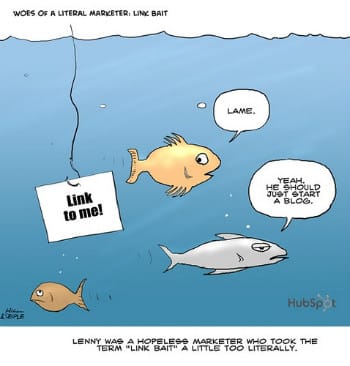
The word “linkbait” might sound at first like something exploitive or cheap, but the fact is that its place in an effective content marketing campaign is assured for the foreseeable future. Here’s a look at why that is.
What Is Linkbait, Anyway?
Linkbait can mean the difference between content that’s “just okay” and content that just begs to be shared, right now, with everybody. The name itself might be unpleasant; the word “bait,” after all, is an integral part of phrases like “bait and switch.” The good news is that there’s nothing inherently dishonest or exploitive about linkbait, despite the relatively inelegant name.
In fact, the Internet is full of editorials from experienced marketers that give linkbait their wholehearted endorsement as a sound marketing practice. To put it simply, linkbait refers to a type of content that readers will be compelled to click on, because they expect it to benefit them in some way. Linkbait can take many forms, but the endgame is always the same: to entice readers to click a link with the promise of high-quality content. Of course, delivering on that promise is another story entirely.
What Does Linkbait Look Like?
If you want to take advantage of linkbait as a method of capturing the public’s attention and loyalty, you’ll want to familiarize yourself with the types of linkbait that are at your disposal, and take a look at which ones have proven track records.
Some of the very best linkbait out there are articles that promise to teach the reader something. As a result, articles with “How To” or “Beginner’s Guide” in the title can be highly attractive.
In addition, readers are always on the lookout for useful resources about the topics they’re interested in. Consequently, another type of linkbait you should consider is an extensive resource list, such this one, compiled by 12 Keys. Because they maintain this list, they have gotten many high-quality links from universities, health organizations and other health institutions. If linkbait is about offering the best of the web, then turning your website into a valuable and credible resource for readers is a great way to ensure not only that they return again and again, but also that they’re sharing your resources with their friends and family.
Quality linkbait can also be highly visual. If the information you hope to pass on to your readers is numbers-based, you’ll probably want to spend a great deal of time thinking about the best way to visualize your data. A great way to go is to build an infographic. Infographics offer an uncomplicated way for your readers to learn about your brand, the issues that matter to you or the values that you stand for.
Is Linkbait Future-Proof?
As one of the driving forces behind content marketing strategies, Google has a tendency to make the SEO and marketing worlds nervous any time they introduce a change to their search algorithms. Most of the time-honored SEO practices are still alive and well, but with each algorithm update, Google has propelled us closer to the end of link building as we know it.
While link building is still alive and kicking, it’s our approach and even our very definition of the practice that needs to change with the times. That’s where linkbait comes in.
Link building is the process whereby quality online content is encouraged to go viral. Marketers take advantage of the influencers in their niche and their own contributions to social circles and online communities to distribute their brand across the web. The thing is, Google is actively forcing content marketers to pursue more organic approaches to link building. Linkbait, coupled with a sound social media campaign, could prove to be that missing link.
No matter what Google does, and no matter how radically they redesign their framework or their algorithms, high-quality content will always be the order of the day. Where and how that quality is shared is changing, however. Today, quality linkbait thrives on social networks like Facebook, Twitter and Pinterest, where passing on a piece of content that inspires laughter, thought or self-improvement is as simple as hitting the Share, Retweet or Pin button.
As marketers, we’re the ones who get the ball rolling. Fortunately for us, the tools to do so are already available. Thanks to Google, Facebook and the rest of the Internet giants, we really don’t need to actually build a new framework. Instead, the task that falls to us is as straightforward, albeit somewhat difficult: to use our creativity to provide something compelling and valuable for our audience.